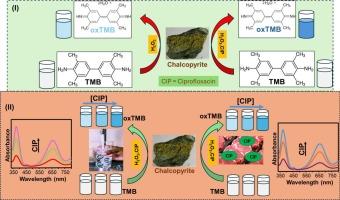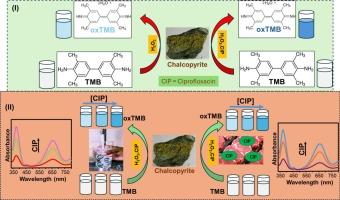From mineral to sensing: Colorimetric determination of ciprofloxacin from water and food samples using natural chalcopyrite as nanozyme
IF 9.8
1区 农林科学
Q1 CHEMISTRY, APPLIED
引用次数: 0
Abstract
A simple and efficient method for detecting the widely used antibiotic Ciprofloxacin (CIP) in different media is crucial. In this study, we employed a colorimetric method using natural chalcopyrite (CuFeS2) with enzyme-mimic activity to detect CIP. The natural CuFeS2 which shows peroxidase-like activity using 3,3′,5,5′-tetramethylbenzidine (TMB) was used as a chromogenic substrate. The absorption intensities of oxidized TMB (oxTMB) that show the peroxidase-like activity of CuFeS2, increased proportionally with increasing CIP concentration. The increment linearly regressed over a concentration range of 0.5–15 μM. The limit of detection (LOD) was found to be 0.21 μM. The method is more responsive to CIP showing higher absorption intensity for the oxTMB than other tested molecules and metal ions. It further proved to be feasible in determining CIP concentration in tap water and beef with recovery rates of 88–101 % and 91–101 %, respectively. Our results indicate that this method could be applicable in measuring CIP in environmental and food samples. This study opens an avenue for exploring similar readily available minerals as nanozymes for sensing and other applications.


从矿物到传感:用天然黄铜矿作为纳米酶比色法测定水和食品样品中的环丙沙星
寻找一种简便、高效的方法检测不同培养基中广泛使用的抗生素环丙沙星(CIP)至关重要。在本研究中,我们采用具有酶模拟活性的天然黄铜矿(CuFeS2)比色法检测CIP。以3,3 ',5,5 ' -四甲基联苯胺(TMB)为显色底物,得到具有过氧化物酶样活性的天然CuFeS2。显示CuFeS2过氧化物酶样活性的氧化TMB (oxTMB)的吸收强度随着CIP浓度的增加而成比例增加。在0.5 ~ 15 μM的浓度范围内,增量呈线性回归。检测限(LOD)为0.21 μM。该方法对CIP反应更灵敏,对oxTMB的吸收强度高于其他被测分子和金属离子。结果表明,该方法测定自来水和牛肉中CIP浓度是可行的,回收率分别为88-101 %和91-101 %。结果表明,该方法可用于环境和食品样品中CIP的测定。这项研究为探索类似的易于获得的矿物作为纳米酶用于传感和其他应用开辟了一条途径。
本文章由计算机程序翻译,如有差异,请以英文原文为准。
求助全文
约1分钟内获得全文
求助全文
来源期刊

Food Chemistry
工程技术-食品科技
CiteScore
16.30
自引率
10.20%
发文量
3130
审稿时长
122 days
期刊介绍:
Food Chemistry publishes original research papers dealing with the advancement of the chemistry and biochemistry of foods or the analytical methods/ approach used. All papers should focus on the novelty of the research carried out.
 求助内容:
求助内容: 应助结果提醒方式:
应助结果提醒方式:


